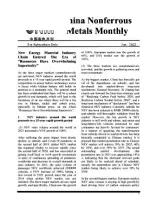CPI Challenges CHINALCO in Aluminum Business
China Power Investment Corporation (hereinafter referred to as CPI), one of the top 5 power generation groups, grows rapidly in aluminum business, making CHINALCO (hereinafter referred to as CHINALCO), the traditional No. 1 company in aluminum business, under great pressure
On August 25, Li Shulei, President of CPI Huanghe Hydropower Development Co, Ltd.(hereinafter referred to as HHDC) indicated that HHDC has a production capacity of 555,000 tons of aluminum after 3 years’ construction and development. The project is the largest single aluminum production system with greatest capacity in high-altitude areas. On this basis, HHDC has preliminarily fostered water-power- aluminum integration industry chain.
The integrated aluminum industry chain is a new weapon in the current competition of the aluminum industry in China. In recent years,since alumina price remained low, electric power cost has become the core of aluminum competition. Electric power cost has accounted for approximately 40% in aluminum production cost.
However, against a backdrop of strict government control of aluminum production capacity,CPI’s aluminum operation was under restrictions. In order to increase self-sufficiency degree of upstream resources, CPI began to extend the aluminum industry chain to bauxite and alumina.
Since 2003, CPI has begun to vigorously develop aluminum business by making use of its advantages in electric power. In 2010, CPI’s aluminum production capacity reached 1,840,000 tons, next only to CHINALCO, the largest aluminum manufacturer of China.
CPI’s current position in aluminum sector is a result of business transformation. For a long time, thermal power generation enterprises have been in a deficit position due to the distorted pricing mechanism of “market reletaed coal price but planned electricity price”. In order to get rid of this situation, CPI began to expand businesses related to electric power and has formed 3 separate sections, i.e, electricity,coal and aluminum.
Li said that HHDC decided to merge and expand aluminum projects in Qinghai because of the low on-grid price of the province. Thus, it is better to utilize the electricity to develop aluminum sector, reduce aluminum cost and increase hydroelectric competitiveness than to sell it at a low price.
CPI’s aluminum projects are located in Inner Mongolia, Ningxia and Qinghai, and mainly adopt coal-electricity-aluminum and waterelectricity- aluminum modes.
While CHINALCO is troubled by higher average electricity price due to unreasonable geographical distribution of aluminum production capacity and backward technologies and equipment as a result of obsolete production lines. Therefore, CPI remained in a leading position in aluminum sector for a time, and its aluminum business has become a new growth point.
However, as CHINALCO accelerated its integrated construction, it has narrowed the gap with CPI in terms of electric power cost. In 2011, Xiong Weiping, President of CHINALCO, reiterated that CHINALCO will speed up its integrated construction of coalelectricity-aluminum and continue to make inroads into coal and electric power markets.
An insider of CHINALCO indicates, as a result of increasing shortage of electric power supply,CPI has gradually lost its advantages enjoyed several years ago. Moreover, CHINALCO is increasing its proportion of self-provided electricity, thus gradually narrowing its gap with CPI in electric power cost.
Li Shulei admits that, like CHINALCO, CPI also needs to purchase electric power from power grid, and thus, electricity price rise will increase the cost of the aluminum business.
However, as aluminum price has begun to rebound, CPI’s aluminum business, which was hit by the financial crisis, has recovered its profitability.
CPI is not satisfied with its achievement in aluminum. It has begun to set foot in the field of upstream aluminum resource in order to increase the degree of self sufficiency. Currently,apart from the 120,000,000 tons of bauxite resources in Guizhou, CPI will exploit bauxite and alumina in Guinea.
An insider notes that CPI exploits bauxite because it is troubled by the bottleneck of upstream raw materials supply in aluminum operation. In recent years, due to violent fluctuation of alumina price, it is increasingly hard for downstream aluminum enterprises to acquire alumina by means of long-term agreement, and many alumina suppliers have to sign related contract at spot price.
Especially, aluminum price rises unexpectedly in 2011, pushing up the price of alumina, which puts pressure on implementation of long-term agreement related to alumina. Li told the reporter that HHDC’s long-term alumina agreement merely accounts for 25% at present, while the remaining 75% is purchased at spot price.
CPI’s plan on investment in alumina has been put on agenda; however, in the view of Bosai,another Chinese alumina company, CPI’s strength lies in aluminum, and the company will surely be bottlenecked by lack of resources if it makes inroads into alumina production.
 China Nonferrous Metals Monthly2011年10期
China Nonferrous Metals Monthly2011年10期
- China Nonferrous Metals Monthly的其它文章
- Lead Production by Province or City in 2011
- Tin Production by Province or City in 2011
- China’s Titanium Gained Great Support Both Nationally and Locally
- Kunpeng Copper: The largest Copper Smelting Company of Sichuan
- The Phase I of Henan Sanfeng Copper Has Completed Construction
- China’s Source Countries of Copper Concentrate Likely to Change
